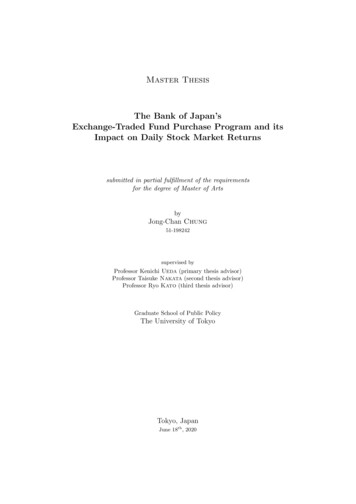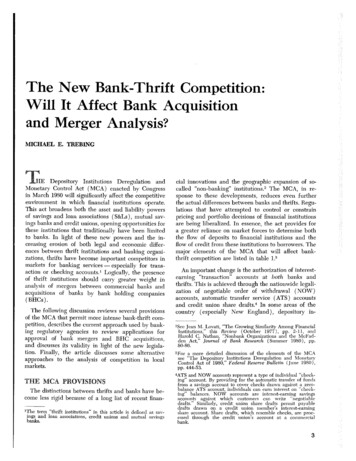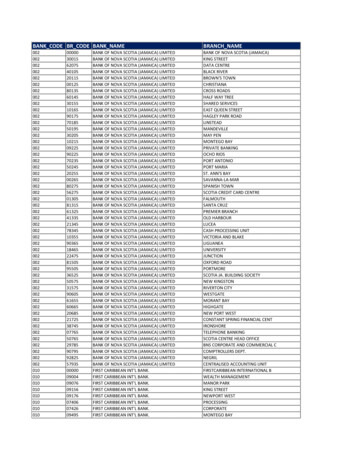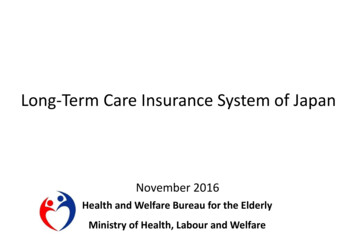
Transcription
Master ThesisThe Bank of Japan’sExchange-Traded Fund Purchase Program and itsImpact on Daily Stock Market Returnssubmitted in partial fulfillment of the requirementsfor the degree of Master of ArtsbyJong-Chan Chung51-198242supervised byProfessor Kenichi Ueda (primary thesis advisor)Professor Taisuke Nakata (second thesis advisor)Professor Ryo Kato (third thesis advisor)Graduate School of Public PolicyThe University of TokyoTokyo, JapanJune 18th , 2020
2020 — Jong-Chan ChungAll rights reserved.
To my parents.
AcknowledgementsI would like to express my great appreciation to my primary thesis advisorProf. Ueda for his valuable and constructive suggestions during the planningand development of this research work. His willingness to give his time sogenerously has been very much appreciated. I am also grateful to Prof. Nakataand Prof. Kato for their insightful words of advice during the presentationof the work in progress. I also thank Prof. Aoki and Prof. Sekine whoselectures on central banking and monetary policy I count to my favorites of thelast two years and whose brains I was allowed to pick on several occasions. Aspecial thanks is given to Prof. Nirei who on a very short notice gave me hissignature to access the school’s Bloomberg Terminal the weekend before thewhole university went into lockdown, narrowly escaping a serious lack of data.A big thanks also goes to Dr. Heckel from the German Institute for JapaneseStudies, a mentor and friend who kindled my interest in central banking duringan internship last summer. I also want to thank all the friends I have madeduring the last two years in Germany and Japan and elsewhere as they haveenriched my journey with memories I cherish. I am particularly thankful toSarah, the most beautiful and kind soul I could ever wish to have by my side.Finally, I embrace my parents to whom I owe so much.
ContentsList of FiguresList of TablesList of AbbreviationsvviviiSummary11 Introduction22 The BOJ’s ETF Program2.1 Purpose . . . . . . . . . . . . . . . . . . . . . . . . . . . . . . .2.2 Evolution . . . . . . . . . . . . . . . . . . . . . . . . . . . . . .4563 Literature Review124 Analysis4.1 Econometric Framework . . . . . . . .4.1.1 Potential Outcome Framework4.1.2 Matching Framework . . . . . .4.2 The Policy Intervention Function . . .4.3 Estimation of the ATT . . . . . . . . .5 ConclusionAppendicesAData Sources .BSoftwares UsedCBonus Graphs .DBonus Tables .14151516172325.Bibliography.272829313436iv
List of Figures2.12.22.32.42.5Treemap: APP under the CME policy . . . . . . . .Daily ETF Spending . . . . . . . . . . . . . . . . . .Monthly ETF Spending . . . . . . . . . . . . . . . .Annual ETF Spending . . . . . . . . . . . . . . . . .Running Total of the BOJ’s ETF Purchase Spending.7101010114.14.24.3TOPIX Return (Morning Session) and Market Intervention (2)Common Support . . . . . . . . . . . . . . . . . . . . . . . . . .TOPIX Return (Morning Session) and Market Intervention (1)192021C.1C.2C.3C.4BOJ ETF Holdings vs. Stock Market Capitalization1BOJ ETF Holdings vs. BOJ Total Assets . . . . . .BOJ ETF Holdings vs. ETF Market Value . . . . . .Interventions and Weekdays . . . . . . . . . . . . . .31323333v.
List of Tables2.12.2Bank of Japan (BOJ)’s Unconventional Policy Tools . . . . . .Outline of ETF related decisions & events . . . . . . . . . . . .4.14.24.34.44.54.6Subsample Descriptives . . . . . . . .Policy Intervention Model . . . . . . .Balance Check: Subsample A . . . . .Balance Check: Subsample B . . . . .Balance Check: Subsample C . . . . .Outcome Model on Matched Data Sets.151822222324A.1 Variables Data Sources . . . . . . . . . . . . . . . . . . . . . . .A.2 Other Data Sources . . . . . . . . . . . . . . . . . . . . . . . . .2829D.1 Policy Intervention Model (modified) . . . . . . . . . . . . . . .D.2 Intervention Effect on Implied Volatility . . . . . . . . . . . . .3435vi.67
List of AbbreviationsAPPAsset Purchase ProgramATEaverage treatment effectATTaverage treatment effect for the treatedBOEBank of EnglandBOJBank of JapanCBcorporate bondCMEComprehensive Monetary EasingCPcorporate paperECBEuropean Central BankELBeffective lower boundETFindex-linked exchange-traded fundFEDFederal Reserve SystemFSOPCfunds-supplying operation against pooled collateralGFCGreat Financial CrisisGPIFGovernment Pension Investment FundJGBJapanese government bondJGSJapanese government securitiesJPX-Nikkei 400 JPX-Nikkei Index 400J-REITJapan real estate investment trustLSAPlarge-scale asset purchaseMPMmonetary policy meetingMFFPmoney-financed fiscal programsNIKKEINikkei 225 Stock AverageP/B Ratioprice-to-book ratioP/E Ratioprice-to-earnings ratioPOFpotential outcome frameworkQEquantitative easingQQEQuantitative and Qualitative Monetary Easingvii
RCTrandomized controlled trialSMPSecurities Markets ProgrammeT-BillTreasury discount billTOPIXTokyo Stock Price IndexVIXCBOE Volatility IndexYCCyield curve controlZLBzero nominal lower boundZIRPzero interest rate policy
SummaryThe Bank of Japan’s ETF purchasing program has evolved from a small andsubsidiary market operation instrument in the early 2010s to a behemothmonetary policy tool, with the central bank now controlling around 80% ofthe domestic ETF market. Given these drastic developments, one wonderswhether the continued existence of this program on the Bank of Japan’sbalance sheet is justified. To clear up this question, it is important to assessthe size and nature of the effectiveness of the central bank led ETF purchases.To this end, the present study attempts to estimate the causal effect of theETF purchases on the TOPIX’s price movements. I draw on the propensityscore matching approach to imitate features of an idealized RCT setting whichallows for a better apples-to-apples comparison of control and treatmentobservations. The results reveal statistically significant price pressure effectson the Japanese stock market’s afternoon session performance under the QQEregime. Effects were non-significant under the Comprehensive MonetaryEasing framework. Furthermore, it is found that the policy interventionfunction is primarily determined by the domestic stock markets morningsession performance. The predictive contributions of other factors mentionedby a high-ranking Bank of Japan member were found to be negligible.1
Chapter 1IntroductionAt the time of the writing, SARS-CoV-2 has not only taken a heavy toll onhuman lives and on the amount of social interactions permissible but has alsoravaged the financial markets, prompting governments to take action withcentral banks in the hot seat. Monetary authorities all around the world havemoved up a gear by cutting interbank rates, purchasing a variety of assets andsetting up lending facilities to provide liquidity, accompanied by commitmentsto exhaust their remaining arsenal if necessary. Amid this bedlam, the BOJdecided to double its upper limit of annual purchases of index-linkedexchange-traded funds (ETFs)1 to the tune of U12 trillion at its 16th of March2020 monetary policy meeting (MPM) (Bank of Japan 2020c). If the BOJ wasto exhaust its ETF-purchasing scope, the central bank would find itself on acourse to well overtake the Government Pension Investment Fund (GPIF) asthe biggest holder of domestic stocks by the end of 2020 (Lewis and Inagaki2020). Accordingly, the BOJ has since bought ETFs worth U721.6 billionwithin a time frame of 10 days with three purchasing transactions valuedU200.4 billion each, representing its largest daily purchases to date. Whilethis unprecedented hike is only the last of a series of measures undertaken bythe Japanese central bank so far to ease monetary conditions for many years,it underscores the increased importance the BOJ wants to assign to its ETFpurchase program.The motivation of the present work is to give guidance to the questionwhether this program has empirical justifications to sustain its existence on theBOJ’s balance sheet. Not only is this question discussed controversially amongmarket participants, it has gained increased attention by foreign media as well2 ,1. “ETFs are traded securities [and each] ETF share is a claim on a trust that holds aspecified pool of assets. [.] ETF shares are created when an authorized financial institutiondeposits a portfolio of securities with the trustee and receives ETF shares in return. TheseETF shares can be sold to other investors. The market for ETF shares operates like themarket for shares of a common stock. Investors can buy or sell ETF shares at any pointduring the day. ETF share prices may diverge from the underlying net asset value (NAV)of the securities held in the trust, although such divergence is restricted by the capacity ofauthorized financial institutions to create and redeem ETF shares.” (Poterba and Shoven2002).2. Themes have been the creation of distortions in the domestic equity market where the2
Chapter: Introductionand the controversy over the continued use and growing scale of this marketoperation has been reflected even in the central bank’s decision-making PolicyBoard:“Mr. T. Sato dissented considering that ETF purchases of about6 trillion yen annually would be excessive in light of their adverseimpact on the price mechanism in the stock market and the Bank’sfinancial soundness. Mr. T. Kiuchi dissented because an increasein ETF purchases would (1) impair the Bank’s financial soundness,(2) lead to a rise in volatility in the stock market, and (3) give awrong impression that the Bank targeted stock prices.” (Bank ofJapan 2016d, MPM July 2016).This research serves to complement the literature on the effectiveness ofunconventional monetary policy when nominal interest rates are constrainedby a lower bound. More specifically, it contributes to the yet small but growingliterature on the BOJ’s ETF purchase program and its impact on financialmarkets. The basic idea is to counterfactually answer the question:Would the Japanese equity market have performed worse if the BOJ had notpurchased ETFs?In other words, and clarifying, the exercise is to estimate the causal effectof the Japanese central bank’s ETF purchase interventions on a domestic stockmarket index’s daily total return. Methodologically, this research draws ona matching process and the concept of potential outcomes which facilitatesthinking in counterfactual terms. This is required as causality in the presentnon-experimental setting can only be approached by comparing trading dayswhere the BOJ intervened with similar trading days where an intervention didnot occur and by accounting for the fact that the decision whether to interveneor not is non-random. The proceeding is as follows: First off, an overview of theBOJ’s ETF purchase program is given by explaining the rationale behind theadoption of this non-standard monetary policy measure and by showing howthis market operation has evolved over time since its introduction at the end of2010. Then, the evidence on the effectiveness of the program is summarized byreviewing the academic literature. Thereafter, the methodological frameworkis explicated followed by the presentation and discussion of the results. Here,special attention will be brought to the policy intervention function and theestimation of a causal effect called the average treatment effect for the treated(ATT). The work ends with a discussion of policy implications and an outlookfor future research.valuations are said to be inflated artificially through the central bank’s ETF purchases, furtherexacerbated through disproportionate stakes in companies over-represented in the Nikkei 225Stock Average (NIKKEI) which might lead to compromised corporate governance againstthe backdrop of unexercised share voting rights. Concern has also been raised about theprogram’s exit strategy with investors worrying about stock devaluations once the constantstream of purchases will come to an end (Lewis 2019; Whiffin 2019; Bird 2019).3
Chapter 2The BOJ’s ETF Program“the Bank of Japan was a lonely forerunner and had to feel its way forward,making decisions in the uncharted territory of unorthodox policy”— Shirakawa (2012)So far, other central banks have shunned away from purchasing stocksthrough ETFs even in the aftermath of the Great Financial Crisis (GFC) withits subsequent proliferation of asset purchase programs that target an evergrowing set of different asset classes. To the best of the author’s knowledge,the BOJ’s market operation of purchasing ETFs are unique in the centralbanking world1 . Part of the reason is that this would involve taking on atleast some of the aforementioned risks. The lack of role models and precedentsis another reason. In fact, the BOJ has birthed three distinct ETF relatedprograms: The main program involves the outright purchases of ETFs thatbegan in December 2010 and the operational rules2 can found in the“Principal Terms and Conditions for Purchases of ETFs and J-REITs” (Bankof Japan 2020e). Next, a supplement program was established for purchases ofETFs “with the aim of supporting firms that are proactively investing inphysical and human capital” (Bank of Japan 2017). Lastly, and only recently,the BOJ has introduced ETF lending (Bank of Japan 2019c). For theremainder of the work, the focus will be on the main ETF program.1. Its unconventionality is also evidenced by a lack of mention in Chapter IV of the Bank ofJapan Act (Act No. 89, 1997) that enumerates the bank’s authorized businesses. This makesa separate authorization from the Minister of Finance and the Commissioner of the FinancialServices Agency in accordance with Article 43, § 1 and Article 61-2 of the Bank of JapanAct necessary prior to the implementation of index-linked ETF purchases and subsequentamendments.2. The purchases are made at the Operations Department of the BOJ’s Head Office andeligible ETFs comprise those that are listed on a financial instruments exchange licensed inJapan and that track the Tokyo Stock Price Index (TOPIX), the NIKKEI or the JPX-NikkeiIndex 400 (JPX-Nikkei 400). An appointed trust bank performs the ETFs purchases on theBOJ’s behalf and handles these assets as trust property. While the BOJ reports the date andtotal amount of ETF purchases, it refrains from publishing the exact time of order executionsand whether the order is split into smaller units and distributed over a time period.4
Chapter: The BOJ’s ETF Program2.12.1 PurposePurposeIn earlier times when the BOJ and other central banks were not constrained bythe binding zero nominal lower bound (ZLB) or the effective lower bound (ELB),setting the nominal policy interest rate and keeping it stable represented thecore of the conduct of conventional monetary policy. The reserve requirementsystem allows central banks to flatten the reserve demand curve by varying thequantity of bank reserves, eliciting a high interest rate elasticity of reserves. Incombination with a corridor system with the basic loan rate and the interestrate applied under the complementary deposit facility acting as the policy rateceiling and floor respectively, the BOJ has perfect controllability over the veryshort end of the yield curve dubbed uncollateralized overnight call rate. Formany years however, the BOJ has found itself in a position where it had to resortto unconventional monetary policy to achieve its inflation target. Generallyspeaking, present unconventional monetary policy in the Japanese context canbe thought to consist of four elements3 : zero interest rate policy (ZIRP) (or evenslightly negative interest rate policy), forward guidance about future interestrate policies, quantitative easing (QE)4 or large-scale asset purchases (LSAPs)and lastly yield curve control (YCC) as is reflected by the structure and contentof the BOJ’s statements on monetary policy (see for example Bank of Japan2020b)5 . Table 2.1 features these tools in the order of the date of introductionin Japan.The ETF purchase program is designed to support the monetary easingefforts by the BOJ and can be associated with QE. It is different from the stockpurchasing rounds of November 2002 – September 2004 and February 2009 –April 2010 that aimed at helping distressed banks resolve their problems withnon-performing loans and promote financial stability (Shirai 2018). The ETFprogram launched as part of the Asset Purchase Program (APP) that ran fromthe end of 2010 to early 2013, although originally conceived only as a temporarymeasure to be conducted until the end of 2011. The APP itself was situated3. Other measures that have been discussed in the literature include a temporaryintervention in the foreign exchange market in combination with price level targeting andhelicopter money. Svensson (2001) suggested for the BOJ “a foolproof way of escaping fromits liquidity trap and recession, namely combining a price level target path correspondingto positive inflation with a devaluation of the yen and a temporary exchange rate peg tojump-start the economy” while Bernanke (2016) wrote about money-financed fiscal programs(MFFP) as a last-resort strategy which is “an expansionary fiscal policy – an increase inpublic spending or a tax cut – financed by a permanent increase in the money stock”,arguing for its effectiveness even at the ZLB and high debt levels. Just recently, the Bank ofEngland (BOE) agreed to finance additional fiscal spending by the UK government relatedto SARS-CoV-2 (Giles and Georgiadis 2020). Both aforementioned measures would requirea close coordination with the Treasury.4. While associated with balance sheet operations, a narrow definition involves only anincrease of the balance sheet size whereas a narrowly defined credit easing refers to changesin the composition of balance sheets (Shiratsuka 2010; see also Bernanke and Reinhart 2004).An example of the latter was the Federal Reserve System (FED)’s Operation Twist in theearly 60’s (Alon and Swanson 2011).5. Ueda 2012 differentiates unconventional monetary policy between forward guidance offuture policy rates, targeted asset purchases, and quantitative easing.5
Chapter: The BOJ’s ETF Program2.2 EvolutionTable 2.1: BOJ’s Unconventional Policy ToolsToolPeriodZero interest rate policy (ZIRP)Quantitative easing (QE)ZIRPComprehensive Monetary Easing (CME)Quantitative and Qualitative Monetary Easing (QQE)QQE with negative interest rateQQE with YCCFebruary 1999 – July 2000March 2001 – March 2006April 2006 – July 2006October 2010 – March 2013April 2013 –February 2016 –September 2016 –Source: Cabinet Office (2020)within the wider Comprehensive Monetary Easing (CME) policy introduced atthe October 5th 2010 MPM. Recognizing the constraint by the ELB, the centralbank decided to “encourage the decline in longer-term interest rates and variousrisk premiums to further enhance monetary easing” and therefore it judged itnecessary to “establish a program on its balance sheet through which the Bankwill purchase various financial assets” (Bank of Japan 2010a). Thus assumably,the official version of this goal translates into lowering the equity risk premiumwith respect to the purchases of ETFs. Implicitly however, it must have beenclear that as a direct consequence of this market operation the domestic equitymarket valuations would experience an upcurrent6 . Higher share prices wouldnot only create a wealth effect through which consumer spending is bolstered,but also incentivize firms to higher investment spending by reducing their cost ofcapital, eventually stimulating economic activity and exerting upward pressureon price developments7 .2.2EvolutionWhen the ETF purchase program was first introduced, the Policy Board set themaximum
intervention in the foreign exchange market in combination with price level targeting and helicoptermoney. escapingfrom its liquidity trap and recession, namely combining a price level target path corresponding to positive inflation with a de











